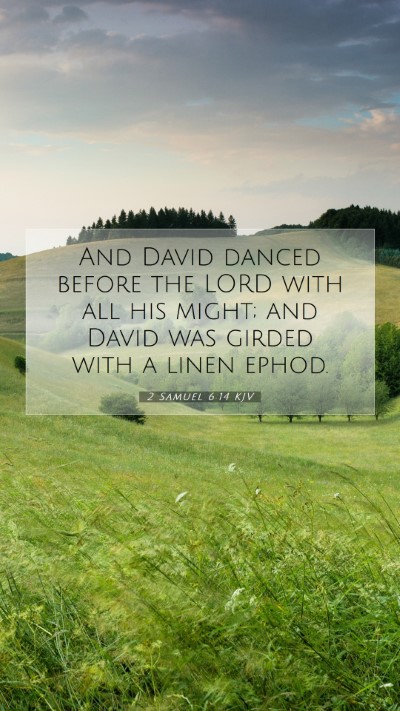Bible Verse Commentary on 2 Samuel 6:14
The verse 2 Samuel 6:14 states, "And David danced before the Lord with all his might; and David was girded with a linen ephod." This passage captures a pivotal moment in King David's reign, highlighting a celebration marked by exuberance and deep reverence for God.
Overview of the Passage
The context of this event involves King David bringing the Ark of the Covenant back to Jerusalem. This act represented not just a political move but a spiritual restoration for Israel. The Ark symbolized the presence of God among His people, and its return was a triumphant occasion.
Commentary Insights
-
Matthew Henry:
Henry emphasizes the joy and fervency of David's worship. He notes that David's dance was not a mere performance but an expression of his heart's devotion to the Lord. The significance of David wearing a linen ephod signifies humility and presentation before God, shedding royal attire for simple priestly garments to embody the worship spirit.
-
Albert Barnes:
Barnes discusses the physicality of worship demonstrated by David's actions. He suggests that true worship is often marked by an abandonment to joy in God's presence. David's dance illustrates that it is acceptable to express oneself passionately in worship, challenging the norms of dignity that often inhibit heartfelt connection with the Divine.
-
Adam Clarke:
Clarke draws attention to the cultural implications of David’s act. Dancing in worship was not uncommon in ancient cultures; it signified victory and worship. Clarke contrasts David’s celebration with the later criticisms he faced, noting that genuine worship can invite misunderstanding from those around us, yet it remains essential for spiritual integrity.
Understanding the Verse
In comprehending 2 Samuel 6:14, several focal points emerge:
-
Joyful Worship:
This passage underscores the importance of joy in worship. David's uninhibited dance symbolizes a heart fully surrendered to God, exemplifying how believers should approach worship with enthusiasm and gladness.
-
Simplicity Before God:
The linen ephod represents humility and sincerity. By opting for this modest garment, David highlights that true worship is not about outward appearance but the condition and intent of one's heart.
-
Cultural Context:
Understanding the cultural implications of dance during worship in David's time aids in interpreting his actions. It reflects a communal celebration of God’s presence and favor upon Israel.
Application of the Verse
Applying the insights from 2 Samuel 6:14 encourages personal reflection on how we engage in worship:
-
Expressing Joy:
Encourage individuals or groups to find ways to express joy in their worship, recognizing that worship can include various forms of celebration and artistic expression.
-
Humility in Worship:
Highlight the importance of humility, urging believers to approach God without pretense, instead focusing on the heart’s posture in worship.
-
Overcoming Criticism:
Equip believers to be resilient against potential criticism for their worship practices, emphasizing that the audience of one—God—should be the ultimate focus.
Cross References
- Psalm 149:3: "Let them praise His name with dancing..." - Celebrating God with dance as part of worship.
- 2 Samuel 6:20-22: David’s wife Michal criticized him for his public display of worship, highlighting the challenges of expressing faith openly.
- 1 Chronicles 15:29: The return of the Ark of the Covenant and its associated celebrations, underscoring Israel’s joy and reverence.
Conclusion
2 Samuel 6:14 serves as a powerful reminder of the nature of true worship. It invites believers to engage fully with their hearts in worship, embracing joy, humility, and authenticity in their expressions of faith. The rich context provided by commentaries enhances our understanding of this meaningful verse, encouraging a deeper connection with our worship practices.


